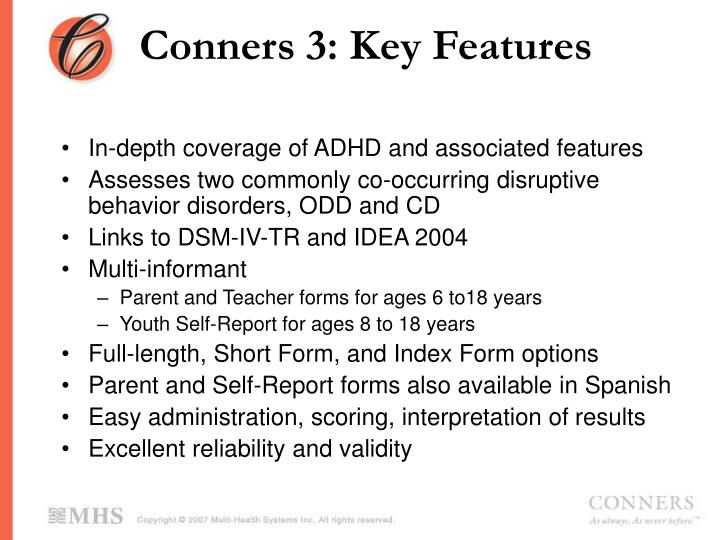

- #CONNERS TEACHER RATING SCALE FORM FULL#
- #CONNERS TEACHER RATING SCALE FORM SERIES#
The scores are then converted to standardized scores, known as T-scores. They will assign the raw scores to the correct age group column within each scale. Your child’s psychologist will total the scores from each area of the test. The form compiles scores in each of the following areas: Your child’s doctor will evaluate the results after you complete your Conners CBRS-parent form. Comprehensive reports can be prepared and sent to your child’s doctor, with your permission. The psychologist will interpret and summarize the results for each child, and review the findings with you.
 classify and qualify students for inclusion or exclusion in special education programs or research studies. offer standardized clinical information to support any decisions made by your doctor. establish an emotional, behavioral, and academic baseline before beginning therapy and medication. help your healthcare team develop an intervention and treatment plan for your child. provide a perspective on a child’s behavior from people who interact closely with the child on a regular basis. measure hyperactivity in children and adolescents. No matter which version is used, the key purposes of the Conners CBRS are to: The short version can be used to monitor your child’s response to treatment over time. The long versions are often used as initial evaluations when ADHD is suspected. The form can take anywhere from five minutes to an hour and a half to complete, depending on which version you’re asked to fill out. The Conners Clinical Index (Conners CI) is a shorter 25-question version. They also help children who have ADHD understand the severity of their disorder. Conners CBRS forms help to diagnose children who otherwise may have been overlooked. These forms are often distributed to schools, pediatric offices, and treatment centers to screen for ADHD. The multiple-choice questions range from “How often does your child have trouble going to sleep at night?” to “How hard is it to focus on a homework assignment?” Together they help create a comprehensive inventory of a child’s behaviors. These forms ask questions that help screen for emotional, behavioral, and academic disorders. one that’s a self-report to be completed by the child. The Conners CBRS is suitable in assessing children ages 6 to 18. These disorders can include depression, aggression, or dyslexia. They can also look for signs of other emotional, behavioral, or academic disorders. By analyzing your responses, your psychologist can better determine whether or not your child has ADHD.
classify and qualify students for inclusion or exclusion in special education programs or research studies. offer standardized clinical information to support any decisions made by your doctor. establish an emotional, behavioral, and academic baseline before beginning therapy and medication. help your healthcare team develop an intervention and treatment plan for your child. provide a perspective on a child’s behavior from people who interact closely with the child on a regular basis. measure hyperactivity in children and adolescents. No matter which version is used, the key purposes of the Conners CBRS are to: The short version can be used to monitor your child’s response to treatment over time. The long versions are often used as initial evaluations when ADHD is suspected. The form can take anywhere from five minutes to an hour and a half to complete, depending on which version you’re asked to fill out. The Conners Clinical Index (Conners CI) is a shorter 25-question version. They also help children who have ADHD understand the severity of their disorder. Conners CBRS forms help to diagnose children who otherwise may have been overlooked. These forms are often distributed to schools, pediatric offices, and treatment centers to screen for ADHD. The multiple-choice questions range from “How often does your child have trouble going to sleep at night?” to “How hard is it to focus on a homework assignment?” Together they help create a comprehensive inventory of a child’s behaviors. These forms ask questions that help screen for emotional, behavioral, and academic disorders. one that’s a self-report to be completed by the child. The Conners CBRS is suitable in assessing children ages 6 to 18. These disorders can include depression, aggression, or dyslexia. They can also look for signs of other emotional, behavioral, or academic disorders. By analyzing your responses, your psychologist can better determine whether or not your child has ADHD. This helps your psychologist gain a full understanding of their behaviors and habits.
A Conners CBRS parent form will ask you a series of questions about your child. Psychologists must gather details about your child’s home life to properly diagnose ADHD. The psychologist may ask you to complete a Conners Comprehensive Behavior Rating Scales (Conners CBRS) parent form if they agree that your child shows typical ADHD behaviors.

Your doctor may recommend your child see a psychologist for further diagnostic assessments. The first thing you should do is talk to your doctor. If so, you may suspect that your child has attention deficit hyperactivity disorder (ADHD). You may have noticed that your child has difficulty in school or problems socializing with other children.







 0 kommentar(er)
0 kommentar(er)
